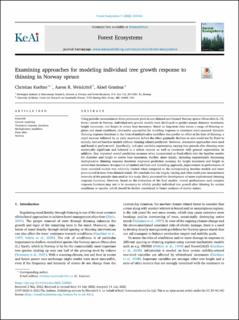| dc.contributor.author | Kuehne, Christian | |
| dc.contributor.author | Weiskittel, Aaron R. | |
| dc.contributor.author | Granhus, Aksel | |
| dc.date.accessioned | 2022-10-07T12:30:41Z | |
| dc.date.available | 2022-10-07T12:30:41Z | |
| dc.date.created | 2022-07-20T13:40:23Z | |
| dc.date.issued | 2022-08-02 | |
| dc.identifier.citation | Forest Ecosystems. 2022, 9 . | en_US |
| dc.identifier.issn | 2197-5620 | |
| dc.identifier.uri | https://hdl.handle.net/11250/3024534 | |
| dc.description.abstract | Using periodic measurements from permanent plots in non-thinned and thinned Norway spruce (Picea abies (L.) H. Karst.) stands in Norway, individual-tree growth models were developed to predict annual diameter increment, height increment, and height to crown base increment. Based on long-term data across a range of thinning regimes and stand conditions, alternative approaches for modeling response to treatment were assessed. Dynamic thinning response functions in the form of multiplicative modifiers that predict no effect at the time of thinning, a rapid increase followed by an early maximum before the effect gradually declines to zero could not be fitted to initially derived baseline models without thinning related predictors. However, alternative approaches were used and found to perform well. Specifically, indicator variables representing varying time periods after thinning were statistically significant and behaved in a robust manner as well as consistent with general expectations. In addition, they improved overall prediction accuracy when incorporated as fixed effects into the baseline models for diameter and height to crown base increment. Further, more simply, including exponentially decreasing multiplicative thinning response functions improved prediction accuracy for height increment and height to crown base increment. Irrespective of studied attribute and modelling approach, improvement in performance of these extended models was relatively limited when compared to the corresponding baseline models and more pronounced in trees from thinned stands. We conclude that the largely varying and often multi-year measurement intervals of the periodic data used in this study likely prevented the development of more sophisticated thinning response functions. However, based on the evaluation of the final models’ overall performance such complex response functions may not to be necessary to reliably predict individual tree growth after thinning for certain conditions or species, which should be further considered in future analyses of similar nature. | en_US |
| dc.language.iso | eng | en_US |
| dc.publisher | Elsevier B.V. on behalf of KeAi Communications Co. Ltd | en_US |
| dc.rights | Attribution-NonCommercial-NoDerivatives 4.0 Internasjonal | * |
| dc.rights.uri | http://creativecommons.org/licenses/by-nc-nd/4.0/deed.no | * |
| dc.title | Examining approaches for modeling individual tree growth response to thinning in Norway spruce | en_US |
| dc.title.alternative | Examining approaches for modeling individual tree growth response to thinning in Norway spruce | en_US |
| dc.type | Peer reviewed | en_US |
| dc.type | Journal article | en_US |
| dc.description.version | publishedVersion | en_US |
| dc.rights.holder | © 2022 The Authors | en_US |
| dc.source.pagenumber | 9 | en_US |
| dc.source.volume | 9 | en_US |
| dc.source.journal | Forest Ecosystems | en_US |
| dc.identifier.doi | 10.1016/j.fecs.2022.100060 | |
| dc.identifier.cristin | 2038919 | |
| dc.relation.project | Norges forskningsråd: 301745 | en_US |
| dc.source.articlenumber | 100060 | en_US |
| cristin.ispublished | true | |
| cristin.fulltext | original | |
| cristin.qualitycode | 1 | |

